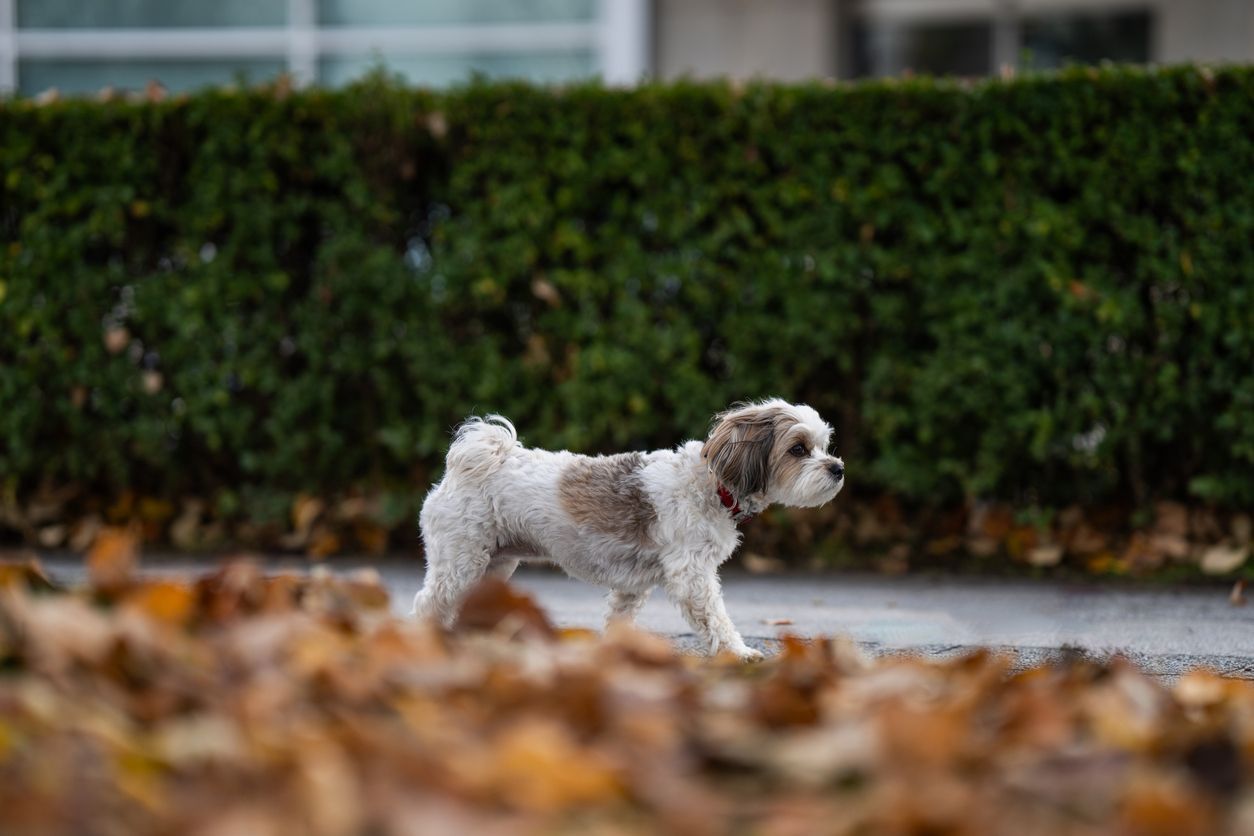What to do if your dog has a white bump on their eyelid

Disclaimer: This article, its content and related references, does not constitute veterinary advice and should not be considered a substitute for veterinary care.
Eyelid masses, bumps, and growths are very common in dogs. While it’s common for a dog to get white and pimple-like eyelid bumps, they can also develop masses that vary in size, shape, and color as well as severity. While most white eyelid masses are benign tumors or cysts of the oil glands at the margins of the lids (meibomian glands), others can be the result of an infection or cancer. It’s important for pet parents to seek veterinary care if they notice eyelid growths on their dog, rather than attempt to treat them at home. If your dog has an eyelid bump, read on to discover:
- Common types of white eyelid growths in dogs
- Symptoms associated with canine eyelid masses
- How eyelid bumps in dogs are diagnosed and treated
Even if they are benign, growths on the eyelids or along the eyelid margin can be irritating to the eye or cause a dog to paw at their eye, risking eye damage. Different types of masses around the eyes can look very similar to each other, so diagnostic testing by a vet is needed to determine what kind of growth it is and how to effectively treat it. Not all eyelid growths require treatment. When treatment is indicated, options include topical or oral medications, or surgical removal of the mass.
What is the white bump on my dog’s eyelid?
Eyelid bumps and masses can vary in size, color, and shape. Many are white, pink, or red, and may appear pale in color. White bumps on a dog’s eyelid can look like pimples, cysts, warts, or small raised spots. There are a few common eyelid masses in dogs that can look white and pimple-like.
Meibomian gland cyst (chalazion)
A meibomian gland cyst, or chalazion, forms when oily secretions produced by a meibomian gland build up as a result of a blockage in the drainage duct. Dogs have multiple meibomian glands lining the margins of the eyelids parallel to the lashes, and they secrete an oil that makes up part of the tear film. This oil helps protect and lubricate the eyes by stabilizing the tear film and flushing away disease-causing microbes and organic debris from the eye. These eyelid glands can become blocked or backed up, leading to an inflammatory response and the formation of a small cyst.
Chalazia are often painless and can be left alone if they’re causing no issues for the affected dog. Some may go away on their own without medical treatment. However, other chalazia can irritate or scratch the eye, prevent the eye from shutting properly, or become infected. When this occurs, treatment by a veterinarian is needed.
Eyelid stye (hordeolum)
A hordeolum, or stye, forms when bacteria enters a chalazion, causing it to become infected. Unlike chalazia, styes are often painful when touched and can become very swollen. Some may develop a white spot in the center as they fill with pus due to the infection. It’s best to avoid squeezing a dog’s eyelid stye and to allow a veterinarian to examine and treat it properly.
Meibomian gland tumors
Meibomian glands along the eyelid margins can grow tumors. Eyelid tumors are very common in dogs, especially seniors, and can appear pale, or pink or red in color. Most meibomian gland tumors are benign adenomas — noncancerous tumors — though rarely, cancerous adenocarcinomas can develop. Though meibomian gland adenomas aren’t malignant, they can grow large enough to irritate the eye or prevent it from closing all the way. Surgery is usually necessary to remove eyelid tumors that are causing problems. Other types of eyelid tumors are uncommon in dogs.
Wart (viral papilloma)
Warts, or papillomas, are caused by a harmless papillomavirus. Viral papillomas can grow anywhere on the body, including on and around the eyelids. Most warts in young dogs are found around the eyes and mouth and may appear as white bumps on the eyelid. Papillomas can also be the color of a dog’s skin, light pink, or gray, and can vary in texture from smooth to having a cauliflower-like appearance. Viral papillomas are harmless unless they’re causing eye irritation and typically go away on their own.
Symptoms associated with common eyelid tumors
Besides the presence of the abnormal growth, some eyelid masses cause no other symptoms and do not bother the dog. Other eyelid growths in dogs can irritate the eye and cause symptoms such as:
- Eye discharge or excessive tear production
- Squinting or excessive blinking
- Holding the eye closed
- Rubbing or pawing at the eye
- Redness or swelling around the eye
- Eye redness
Most bumps on the eyelids are either meibomian cysts or benign tumors, but veterinary attention is recommended to get an accurate diagnosis. “Even though most eyelid growths are not cancerous, they can still irritate the eye, become infected, or interfere with normal vision, so veterinary guidance is recommended,” explains Dr. Jo Myers, a veterinarian on Vetster.
How vets diagnose a dog’s eyelid mass
Many different types of eyelid growths have similar appearances, so a diagnosis can’t be made from appearance alone. Veterinarians use diagnostic testing to determine the type of growth and appropriate treatment options. Testing may include:
- Physical examination
- Eye exam
- Microscopic examination of cells from the bump (cytology)
- Bacterial or fungal culture
- Fine needle aspiration
- Tissue biopsy
- Bloodwork
A thorough ophthalmic examination may be recommended to check for eye irritation from the growth. A definitive diagnosis is necessary to determine a treatment plan. Malignant growths, bacterial infections, and benign masses all require different treatment.
Are white eyelid masses an emergency?
Most eyelid masses in dogs are not an emergency. Prompt veterinary care is recommended to determine what kind of mass it is and what should be done about it. Most masses are benign and do not require treatment, while others can be cancerous, infected, or irritate the eye.
How to treat a white bump on a dog’s eyelid
Eyelid bumps on dogs need to be checked by a veterinarian to ensure an accurate diagnosis before they can be treated. Some eyelid bumps on dogs don’t need to be treated and may go away on their own. When treatment for eyelid masses is needed, it may include:
- Cryogenic or surgical removal of the mass
- Eye drops or ointments that contain antibiotics or anti-inflammatories
- Draining of an eyelid stye or abscess
- Oral antibiotics, anti-inflammatories, or pain medication
- Home nursing, such as warm compresses or massaging an impacted gland
If treatment isn’t needed right away, a vet may advise watching the bump and reporting back if anything changes, such as its size or color, or the onset of any other eye symptoms.
Can I treat my dog’s eyelid bump at home?
Do not attempt to pop or treat a dog’s eyelid growth at home without consulting a veterinary professional. Misdiagnosis is likely, and inappropriate treatment can cause damage to the eye or eyelid, be ineffective, and delay proper treatment. Once the type of eyelid bump is known, nonsurgical treatment is usually given at home and does not require your dog to be hospitalized. Surgical removal of eyelid masses is done in a vet clinic but is often an outpatient procedure, allowing patients to go home the same day. Dogs that have had an eyelid mass removed often go home with an e-collar, oral medications, eye medications, and nursing instructions while healing.
What to do if you find a white eyelid mass on your dog
Prompt veterinary attention is recommended any time you notice a new skin growth on your dog. Eyelid bumps and masses are very common and usually not cancerous but can lead to eye irritation or damage. Growths can rub against the eye or be irritating to the dog, leading to them scratching or pawing at their eye. Once a vet determines the type of mass, they can provide a treatment plan. Do not attempt to diagnose, treat, or pop a dog’s eyelid bump without a veterinarian.
If your dog has an eyelid growth, veterinary professionals are available for virtual vet appointments through the Vetster platform.
FAQ - What to do if your dog has a white bump on their eyelid
What does an eyelid stye look like on a dog?
An eyelid stye is an infected growth on an eyelid gland that’s usually painful, swollen, and inflamed. Styes are usually pink or red and may grow large, have a white spot in the center, or contain fluid or pus. Other types of eyelid lumps can have a similar appearance but are treated differently. It’s important to seek veterinary care for stye treatment rather than attempting to pop it yourself at home.
How do you get rid of a sebaceous cyst on a dog’s eyelid?
If your vet has diagnosed your dog with a sebaceous cyst (meibomian gland adenoma) on their eyelid, follow their instructions for how to manage it. Some meibomian gland adenomas don’t cause any problems, so a decision to remove them is purely a cosmetic matter. If you think your dog has a sebaceous cyst, it’s still important to talk to a veterinarian. Many eyelid masses look similar to each other but require different treatment. A veterinarian can determine what the lump is and provide a treatment plan. Treatment may involve eye medication, oral medication, or surgical removal of the growth. Some growths do not need treatment and can be left alone.
Is it ok to pop an eyelid cyst on a dog?
Do not attempt to pop a dog’s eyelid stye or cyst without talking to a veterinarian. Eyelid styes are often very painful, and improper treatment can lead to eye or eyelid damage. In addition, misdiagnosis of eyelid growths is very common in cases where a professional diagnosis by a veterinarian hasn’t been received.




